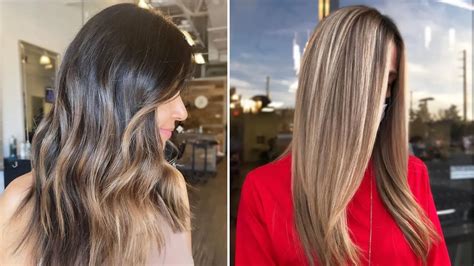Introduction
Highlights and balayage are two popular hair coloring techniques that can add depth, dimension, and style to your locks. While both techniques involve lightening strands of hair, they differ in their application, appearance, and maintenance. Understanding the nuances between these two methods is crucial for achieving your desired hair goals.

1. Application Technique
- Highlights: Highlights are applied using foil or plastic wraps. The hair is sectioned into small strands, and the lightener is applied directly to the strand. The wrap is then sealed, creating a controlled environment for even lightening.
- Balayage: Balayage, a French term meaning “to sweep,” is a freehand painting technique. The lightener is applied to the surface of the hair, creating a more natural, blended look.
2. Placement
- Highlights: Highlights are typically placed throughout the head in a regular pattern. This creates a more subtle, even distribution of color.
- Balayage: Balayage focuses on lightening the ends of the hair and creating a gradation of color. The lightener is applied in a sweeping motion, creating a more lived-in, beachy look.
3. Appearance
- Highlights: Highlights create a more defined, contrasting effect. The lightened strands stand out against the darker base color, resulting in a bold and eye-catching look.
- Balayage: Balayage provides a softer, more blended transition between colors. The lightened strands blend seamlessly into the base, creating a more natural and subtle effect.
4. Maintenance
- Highlights: Highlights typically require more frequent touch-ups as the new growth becomes noticeable at the roots.
- Balayage: Balayage requires less maintenance as the color grows out more gradually and blends better with the natural hair color.
5. Cost
- Highlights: Highlights tend to be more expensive than balayage due to the time and labor involved in the foiling process.
- Balayage: Balayage is generally more affordable, as it is a less time-consuming technique.
6. Damage
- Highlights: Highlights can be more damaging to the hair as they involve chemical processing and heat from the foil.
- Balayage: Balayage is generally less damaging as it uses less product and avoids direct heat application.
7. Suitability
- Highlights: Highlights are suitable for all hair types and textures. They are particularly flattering on shorter hair.
- Balayage: Balayage is best suited for longer hair, as it creates a more blended and natural look.
8. Versatility
- Highlights: Highlights can be customized to create various looks, from subtle to bold. They can also be incorporated into other techniques, such as ombré or sombré.
- Balayage: Balayage offers limited versatility as it is primarily focused on creating a natural, blended effect.
9. Trendiness
- Highlights: Highlights have been a popular hair coloring technique for decades and remain a classic choice.
- Balayage: Balayage has become increasingly popular in recent years, particularly among those seeking a more natural and effortless look.
10. Time
- Highlights: Highlights typically take longer to apply than balayage, as they involve foiling and precise placement.
- Balayage: Balayage is a relatively quick and easy technique to apply.
11. Experience
- Highlights: Applying highlights requires a high level of precision and skill. It is recommended to seek a professional hairstylist for optimal results.
- Balayage: Balayage can be more forgiving and can be attempted at home with some practice and knowledge.
12. Longevity
- Highlights: Highlights tend to last longer than balayage, as the lightened strands are protected by the foil during the application process.
- Balayage: Balayage requires more frequent touch-ups, as the color fades more quickly due to its surface application.
Choosing between highlights and balayage ultimately depends on your individual preferences, hair type, and desired look. Highlights offer a bold, contrasting effect while balayage creates a more blended, natural transition. Whether you prefer a classic or trendy style, understanding the key differences between these two techniques will empower you to make an informed decision and achieve your ideal hair goals.
